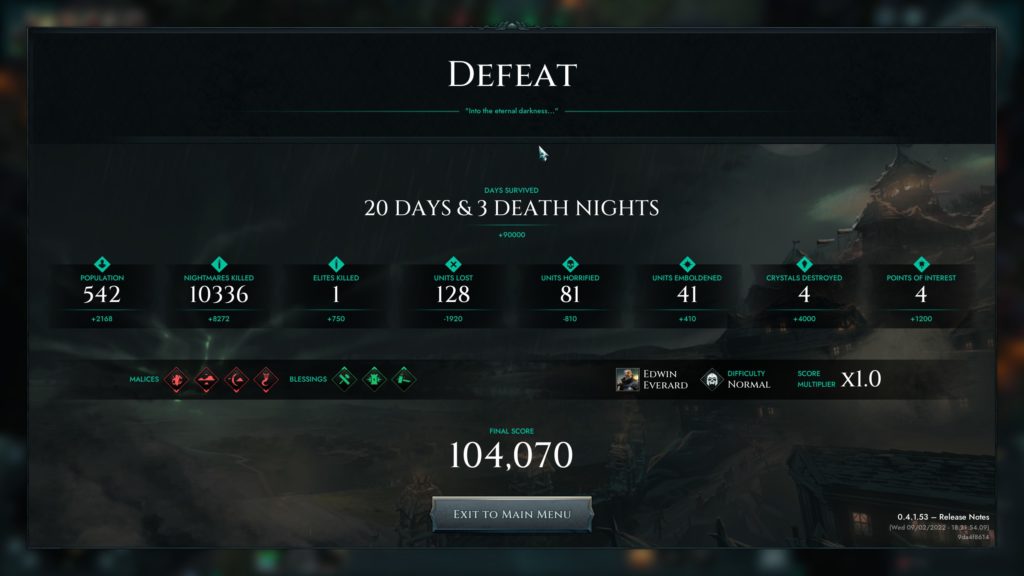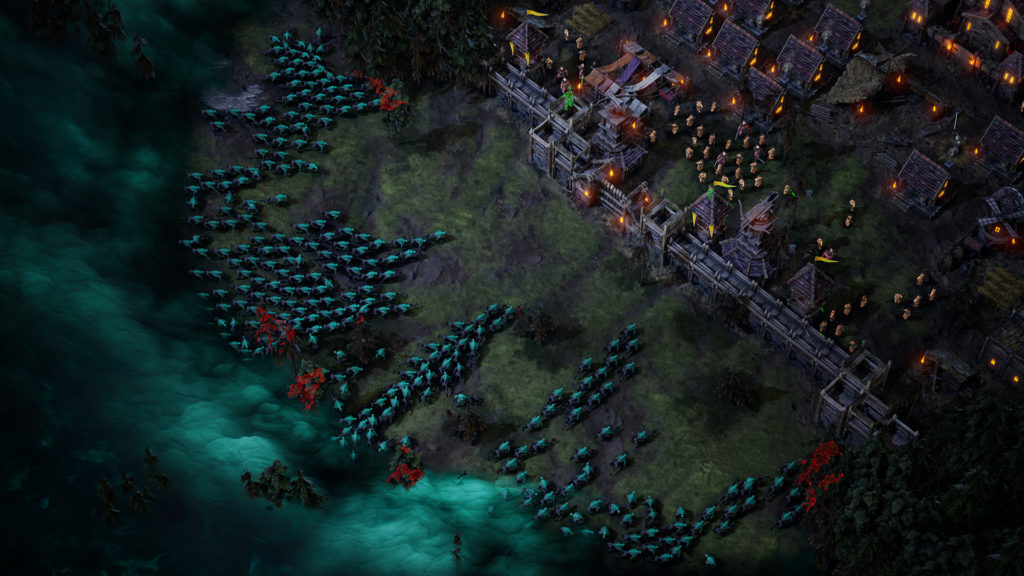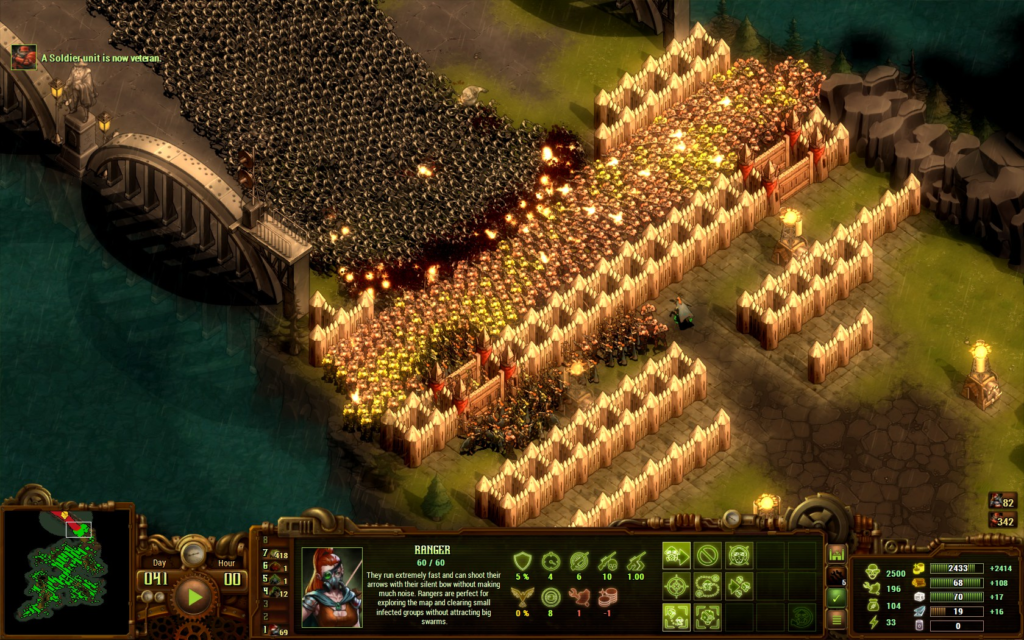The bell tolls, and an indicator appears: the nightmares are coming from the south.
I’ve been aggressively fortifying new expansions, anticipating that the enemy’s next wave will come from somewhere they’ve not previously struck. Now, it seems, they will be poised to attack along two possible paths. One route leads north and east, winding through the unexplored darkness to emerge near a new iron mine, beside a new line of my strongest walls and towers. The towers are each manned by an arbalest and a trio of archers, and nearby stands a large ballista.
The second route goes north and west, this time emerging by a very narrow path through a forest that leads into an area of farmland, and also the previous walls the nightmare horde attacked. The narrow passage is protected by a single tower and a few layers of walls. The more fortified area only has two archer towers, albeit behind two rows of solid walls.
This will be tough. They could strike at any of these three locations. Each is protected to varying degrees, though neither will hold against the numbers I expect. So I add ballistae and more towers for arbalests and archers at each location, and throw up outer lines of staggered low-quality walls. Thanks to a boon earned from surviving a previous nightmare assault, it’s more likely than not that any destroyed building will explode, damaging nearby foes. I move my melee army, lead by our mighty fire-wielding hero unit, into a position midway between the locations, and train more forces to man the new towers and bolster the ground support.
Behind these defences lie unprotected farmlands, resource gatherers and utility buildings. Behind those are incomplete walls of earlier eras, and those are all that stand between invaders and the Keep I must protect. The nightmares will make a beeline towards the Keep, moving like a single hungry swarm. Elsewhere my lands are protected by more solid second layers of defences, but not here. There is no time, and more pressingly there are no more resources, to deal with this problem. The nightmares are here.
Within the first tense moments it becomes clear that they are moving north and west. The new and solid fortifications will not be struck. I order many of the units manning that garrison to move and stand behind the western defences. As the nightmares approach, concealed in the shroud of true night, I pour all incoming resources into more: more ballistae, more towers, more archers to man them, more cheap walls that may explode and burn crowds of the nightmare chaff. Will it be enough?
For precious tens of seconds I see the enemy press up against the outer barricades. As these explode, immolating dozens of assailants, I see the counter of enemy numbers tick down. But they are drops in the ocean of the nightmare thousands. Before long more of the enemy, including deadly melee, ranged and bombing variants, have swept aside the crude barricades. Hundreds more fall to these and incoming fire from the defences, but now the foe are at the true walls and more than four fifths of their numbers stand.
Our hero wades into the fray, calling down a cone of rippling flames that cut through the horde. His greatsword ignites as he cuts through the enemy. Behind him half a dozen sentinels march into battle, their armour and tall shields gleaming. They vanish into the nightmare swarm. The hero’s health drops precipitously as he is targeted by great numbers of the ranged enemy. And then disaster: an abomination explodes against the gates and the hero is killed. This is pivotal. His recharging abilities support cycle charges into the enemy to push them back whilst thinning their numbers; I must fight on without this capability for several minutes until he respawns.
There isn’t time. The walls are broken soon after, the towers assaulted directly, and my army is pushed back by the tide. The nightmares rip through hastily erected defences and civilian buildings as they pour forth. Almost every other garrison is stripped, and these and other reinforcements directed to the Keep and a final line of what defences can be afforded. It is already too late. Even as the Hero respawns, his flames tearing through the enemy tide, the Keep crumbles against the waves and hope is lost. There will be no awaking from this night.

Thanks for indulging me through that narrative. Age of Darkness: Final Stand is an early access survival RTS game in a low fantasy setting. It charges you with expanding your settlement whilst defending it against a map plagued with roving monsters and escalating assaults every few nights. Its fusion of RTS, tower defence and city builder does not guarantee survival. This sense of threat and the probability of failure lend themselves toward exciting tales of valiant defences overwhelmed by endless horrors. Such stories can be a fun way to convey some sense of what a game is about.
If you’re aware of Numantian Games’ They Are Billions, you’re forgiven for thinking much of this familiar. Final Stand has taken a great deal from this predecessor, albeit not the value of a memorable name. Both games share concepts like a settlement that grows radially outward from a central building; tough static defences and more vulnerable but mobile troops used in tandem to clear, secure and colonise new areas; randomly generated maps containing open areas, choke points and valuable resources but strewn with danger; and so on.
They also are close to analogous in some regards. The resources and economy of Final Stand will be instantly familiar to TAB veterans, as are the types of buildings and corresponding tech trees available. After a hundred and fifty hours spent fending off zombies and growing a robust economy, I fell instantly in line with what Final Stand expected of me. You might think of that as a game aware of its antecedents and not changing a system that was not broken and was at the core of what made They Are Billions work; or you might think of it as a game turfing you directly into an over-familiar rut.
It feels more interesting to look at a few of the areas where Final Stand has innovated or taken a different direction. For starters: no zombies. The nightmares are prowling ectoplasmic horrors, but they won’t infect anyone. The most memorable way this plays out in practice is the absence of sudden failure cascades, where infected buildings spawned zombies that instantly infected more buildings, meaning a serious breach in your defences could lead to a ripple effect that tore through your vulnerable economic foundation in moments. Final Stand feels like it offers more opportunity for, well, final stands. It also means that a single stray zombie can’t single-handedly end the game for an inattentive player, so a little less punishing of momentary lapses.

We also have a day-night cycle, which structures the countdown towards the next assault – their source and direction indicated by sinister giant crystals revealed on the map – and offers greater dangers at night. All enemies are more active and dangerous, and elite enemies are revealed near smaller crystals. The game also utilises a fog of war, with buildings and units providing a sight radius. You can only build where you can see: the direction and pace of your expansion is thus determined by the movement of your forces, or the creeping growth of frontier settlements.
In terms of the tools available to me, I haven’t tried everything in the tech tree as yet but it feels like the early access nature of the game begins to show here. There are few area of effect weapons available, and against five thousand nightmares (and fuck knows how many more in subsequent nights) I have felt this absence keenly. There’s a flame tower I’ve yet to unlock, but from what I’ve seen on YouTube I’m uncertain this expensive, slow and short-ranged building has more than niche utility. As far as I can tell there are only four troops: a weaker and stronger version of a single-shot ranged unit, a weak melee unit, and a strong tanky melee unit. I’d like more, please! No doubt new tiers and tools will be on their way as development progresses. (An update: I had failed to discover the siege units, which provide exactly what I felt was lacking. And the flame tower… is underwhelming, but has its uses.)
It’s a remarkably polished game for an early access affair, which makes it easy to forget what you’re playing until you start wondering if there’s more content. My experience was far from bug free, but most of what I noticed was cosmetic or minor pathfinding issues. The one serious issue I repeatedly encountered was my units no longer responding properly to my commands to move. I found that this was fixed by saving or loading the game: merely annoying thanks to this workaround, but probably quite awful if you don’t figure that trick out and lose a lot of troops because they’re not listening to you. But hey! It’s early access, and you must expect such bugs.
I’ll be playing more Final Stand in the weeks to come and I eagerly await whatever is added to the game. Meanwhile, I find myself wondering if Final Stand will cleave to or differ from its direct inspiration in one particular way. They Are Billions was lauded through early access when it was solely an excellent skirmish game, and on final release its long-promised campaign mode proved divisive. (I liked it well enough, despite glacial campaign pacing, but found the 1990’s throwback ‘commando unit’ levels truly awful: a tedious chore of very slowly clearing out a maze where one slip-up could instantly set you back an hour, thanks to the game’s enforced ‘iron man’ save mode.) So: when it comes to expanding its own content, and since Final Stand is so clearly aware of the footsteps in which it treads, how carefully will it place its own feet along that path?


